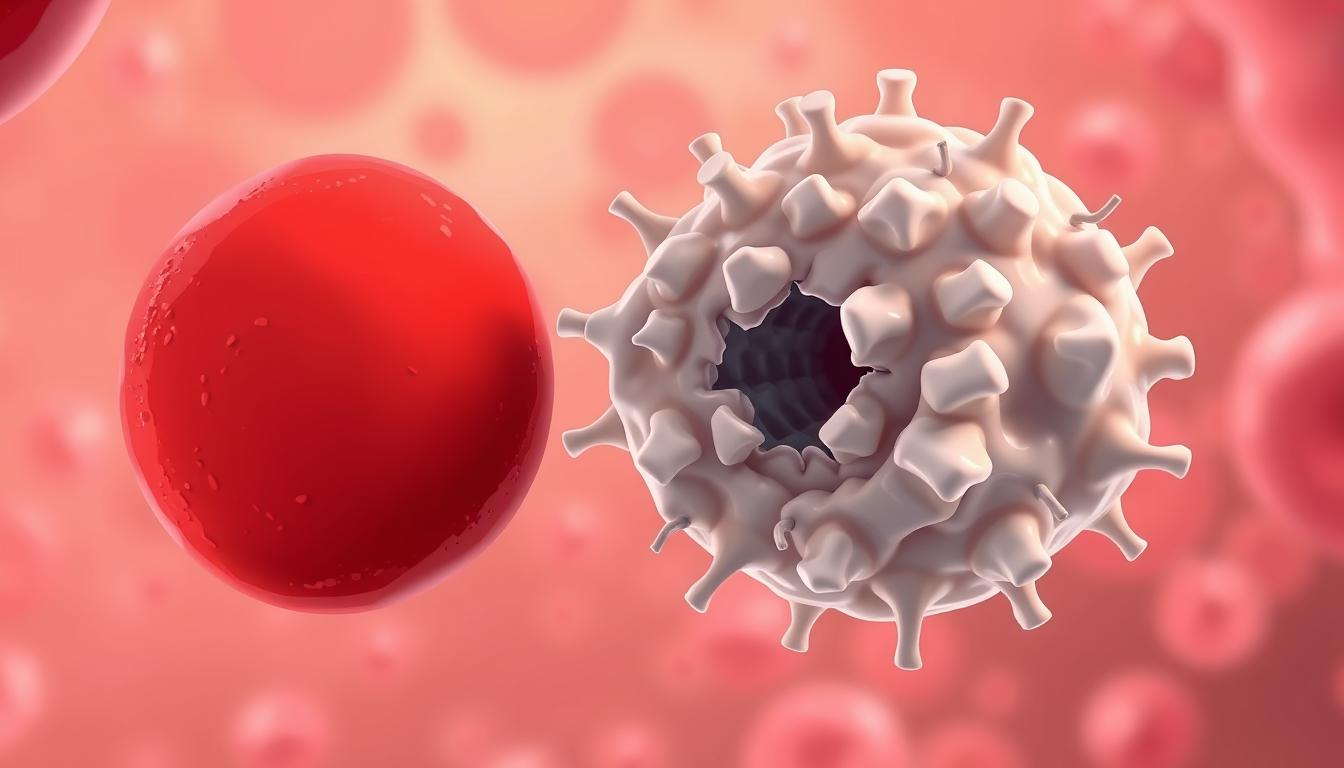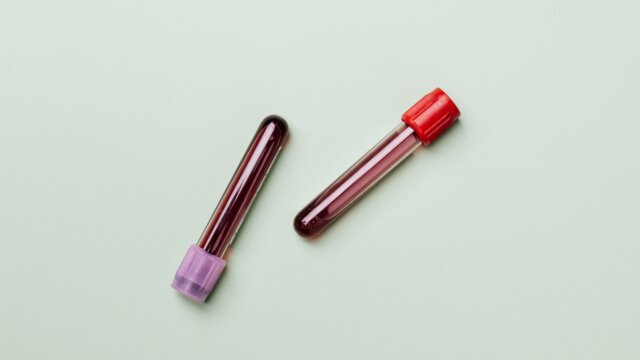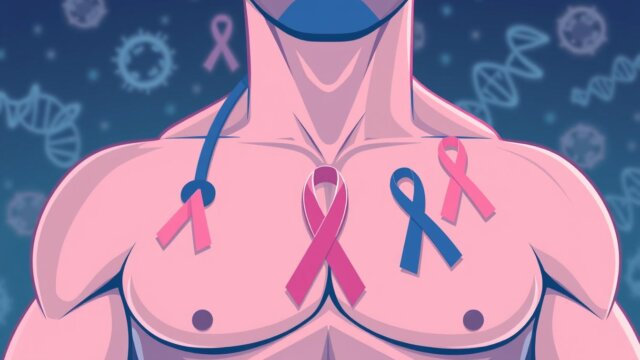FTC disclaimer: This post may contains affiliate links and we will be compensated if you click on a link and make a purchase.
Did you know leukemia, a blood cancer, makes up almost 10% of new cancer cases in the U.S. each year? This fact shows how crucial it is to know about leukemia’s causes, symptoms, and treatments. In this guide, we’ll dive into leukemia, giving you the info to manage your health.
Key Takeaways
- Leukemia is a blood cancer that affects the body’s blood-making tissues, like the bone marrow and lymphatic system.
- It comes in two types: acute (grows fast) and chronic (grows slow) forms.
- Symptoms include fever, tiredness, easy bruising, frequent infections, and swollen lymph nodes.
- Treatments for leukemia include chemotherapy, radiation, stem cell transplants, and targeted therapies.
- Survival rates for leukemia vary based on the type and stage of the disease.
Knowing the basics about leukemia helps you spot signs early and get the right treatment. Remember, you’re not alone. A supportive network and cancer research advancements offer hope and strength to those fighting this disease.
What is Leukemia?
Leukemia is a blood cancer that affects the body’s blood-making parts. This includes the bone marrow and the lymphatic system. It happens when too many bad white blood cells are made. This pushes out the good ones.
Leukemia can be fast or slow. Fast ones get worse quickly, and slow ones take longer.
Types of Leukemia
Leukemia is also split by the type of white blood cell it affects. It can be lymphocytic leukemia, which affects lymphoid cells, or myelogenous leukemia, which affects myeloid cells. There are four main types:
- Acute lymphocytic leukemia (ALL)
- Acute myelogenous leukemia (AML)
- Chronic lymphocytic leukemia (CLL)
- Chronic myelogenous leukemia (CML)
Other types of leukemia and related disorders, like myeloproliferative neoplasms (MPNs), are less common.
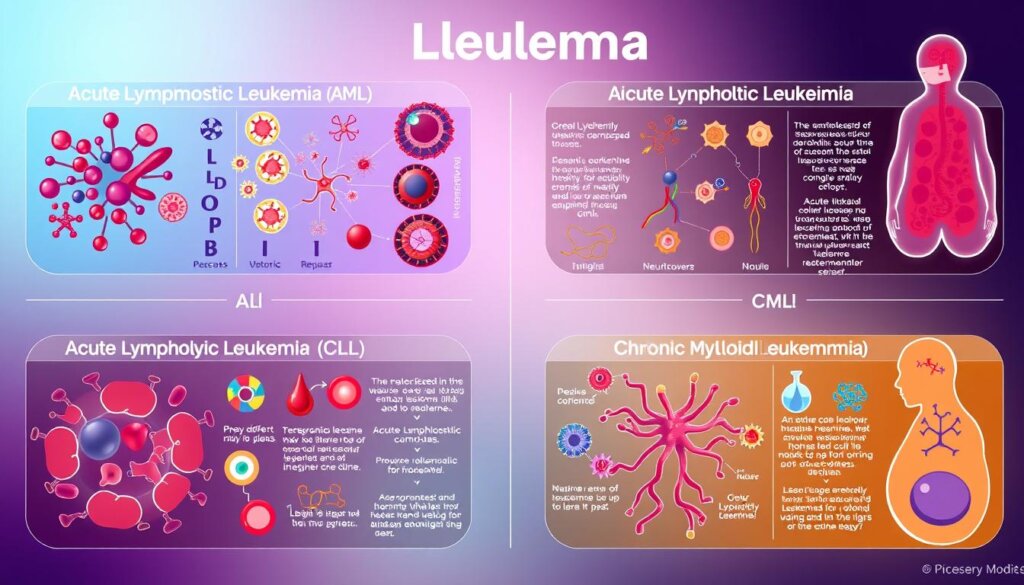
Leukemia Type | Characteristics |
|---|---|
Acute Lymphocytic Leukemia (ALL) | Most common in children but can also affect adults; it progresses rapidly |
Acute Myelogenous Leukemia (AML) | More common in older adults but can affect children; it progresses rapidly |
Chronic Lymphocytic Leukemia (CLL) | One of the most common types in adults often occurs during or after middle age and progresses slowly. |
Chronic Myelogenous Leukemia (CML) | Usually occurs in adults during or after middle age; it progresses slowly |
“Leukemia is the most common cancer in children and adolescents, accounting for almost 1 out of 3 cancers.”
Symptoms of Leukemia
Leukemia symptoms vary by type but include fever, fatigue, and infections. You might also notice weight loss, swollen lymph nodes, and easy bruising. These signs can be similar to other illnesses, so seeing a doctor is key if you notice changes.
Leukemia symptoms often start quickly, like the flu. Many people find out they have leukemia during routine blood tests. It affects how white blood cells are made, causing them to grow too fast.
- Leukemia symptoms include fatigue, weakness, pale skin, excessive sweating at night, unintended weight loss, fever, chills, frequent infections, petechiae, bone pain, swollen lymph nodes, and loss of appetite.
- Leukemia symptoms tend to worsen over time, especially with acute myeloid and acute lymphocytic leukemias.
- Less obvious leukemia symptoms include easy bruising and bleeding, heightened sensitivity to hot and cold temperatures, and tenderness below the left ribcage due to organ enlargement.
Leukemia symptoms often include lasting fatigue and easy bruising. You might also get infections more often or have them last longer.
Symptom | Description |
|---|---|
Petechiae | Petechiae are pinpoint-sized skin spots that occur when a broken capillary allows blood to rise to the skin’s surface, and they are associated with low platelet counts in leukemia. Leukemia spots (petechiae) can be red, purple, or brown and are often found on the arms, midsection, buttocks, and legs. |
Bone Pain | Leukemia bone pain may vary from sharp to dull, continuous ache and can be felt in bones containing a significant amount of bone marrow like the sternum, arms, ribcage, hips, and legs. |
Bruising | Leukemia causes easy bruising due to its impact on the body’s blood clotting ability; bruises can appear anywhere but are most commonly found on the arms and legs. |
Fever and unexplained weight loss can be symptoms of leukemia. Swollen lymph nodes and breathlessness are also possible. Feeling unwell is a common symptom.
Leukemia can cause anemia, leading to tiredness and pale skin. It can also affect platelets, causing spots on the skin and difficulty moving. Increased sweating, especially at night, is another symptom.
An enlarged spleen or liver can indicate leukemia, with symptoms such as bloating and pain. Bone pain, especially in children, can be a result of leukemia.
Acute leukemia may cause signs and symptoms that are similar to the flu, coming on suddenly within days or weeks. Chronic leukemia often causes few symptoms or none at all, with signs and symptoms usually developing gradually. It is often found during a routine blood test.
Specific symptoms of leukemia include fatigue, malaise, loss of appetite, weight loss, fever, shortness of breath, palpitations, weakness, dizziness, easy bruising, nosebleeds, bleeding gums, petechiae, frequent infections, cold sores, vomiting, headache, sore throat, night sweats, bone or joint pain, enlarged lymph nodes, abdominal discomfort, vision problems, sores in the eyes, testicular swelling, chloroma, leukemia cutis, leukocytoclastic vasculitis, and Sweet’s syndrome.
Blood clots can develop due to leukemia, leading to symptoms such as painful or swollen legs, chest pain, difficulty breathing, headaches, vomiting, and vision problems. Acute leukemia can quickly escalate into leukostasis or blast crisis, causing high levels of white blood cells and neurological symptoms. Chloroma, a lump under the skin where leukemia cells collect, is a rare symptom of acute myeloid leukemia (AML).
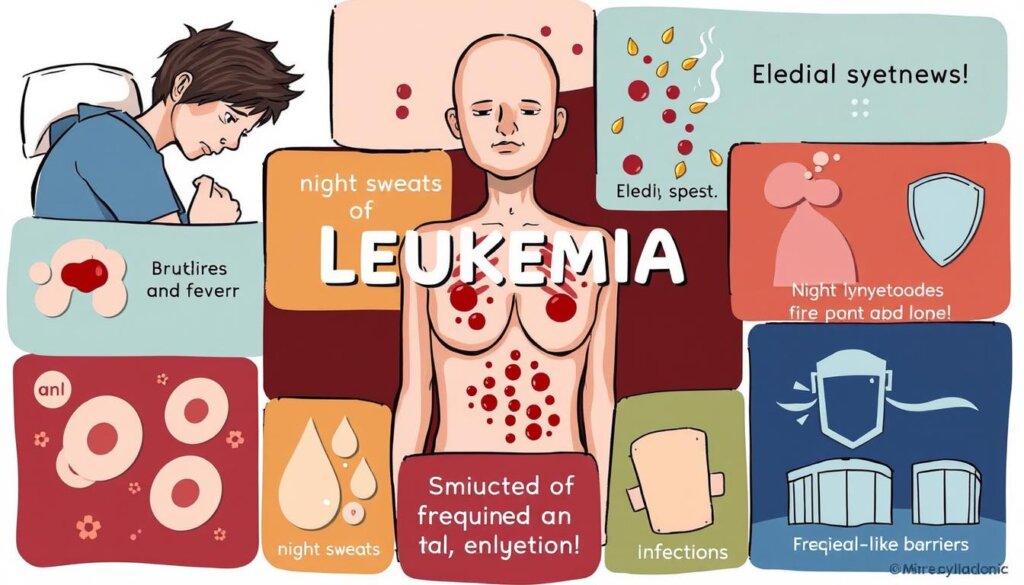
“Early detection and treatment of leukemia are crucial, as the symptoms can be vague and easily mistaken for other illnesses. If you experience any persistent changes in your health, it’s essential to consult a medical professional for proper evaluation and diagnosis.”
Causes and Risk Factors
Genetic and Environmental Factors
Leukemia’s exact causes are still a mystery. It seems to come from a mix of genetic and environmental factors. Changes in blood cell DNA can cause these cells to grow out of control. This increases the risk of leukemia. Some genetic disorders, like Down syndrome, also raise the risk.
Environmental factors might also play a part in leukemia. Exposure to chemicals like benzene and certain cancer treatments can increase the risk. Smoking is also a risk factor, especially for AML.
Many people with leukemia have no known risk factors. And not everyone with these risks will get the disease. Researchers are still trying to understand how genetics and environment lead to leukemia.
Risk Factor | Impact on Leukemia |
|---|---|
Genetic Disorders (e.g., Down syndrome) | Increased risk of leukemia |
Exposure to Chemicals (e.g., benzene) | Increased risk of AML and ALL |
Previous Cancer Treatment (chemotherapy, radiation) | Increased risk of AML and ALL |
Smoking | Increased risk of AML |
Aging | Increased risk of chronic leukemia types |
Gender | Slightly higher incidence in males |
These risk factors don’t mean you’ll definitely get leukemia. But they do increase your chances. Regular check-ups and screenings can catch leukemia early. This makes treatment more effective.
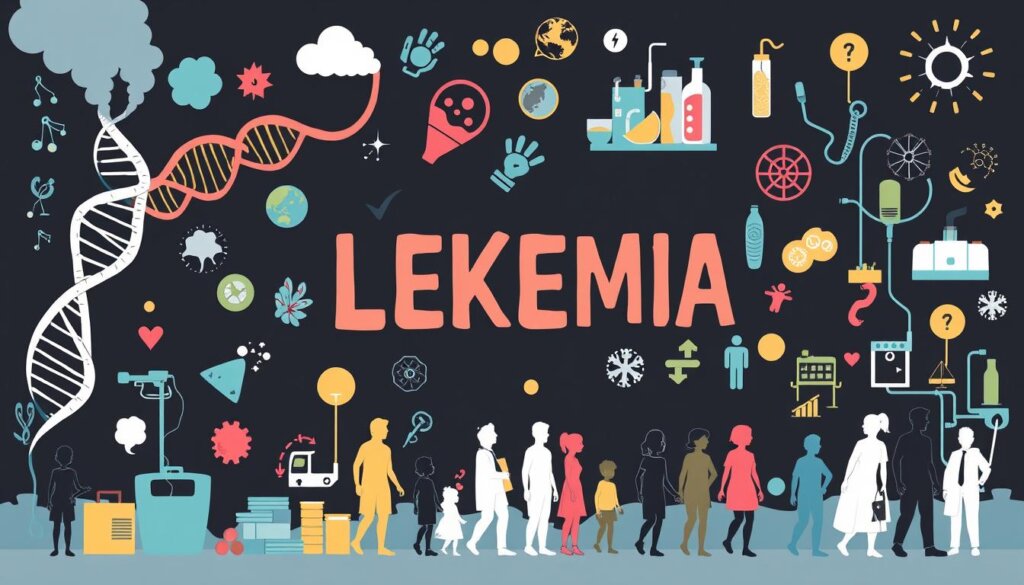
“Cancer is a disease of the genes. It is caused by changes in genes that normally control the way our cells function, especially how they grow and divide.” – National Cancer Institute
Leukemia Diagnosis
Diagnosing leukemia starts with a physical check-up and blood tests. Your doctor will first do a complete blood count (CBC). This checks the levels of red and white blood cells and platelets. If these levels are off, it might mean leukemia.
Your doctor might also do a peripheral blood smear. This looks at your blood cells under a microscope. It helps find leukemia cells in your blood.
If tests show leukemia might be present, a bone marrow biopsy is next. This takes a small bone marrow sample, usually from your hip. It’s checked for leukemia cells to figure out the type and plan treatment.
Tests like flow cytometry and cytogenetic karyotyping might also be done. They look at the leukemia cells’ genetic makeup. This helps decide on the best treatment.
Getting a leukemia diagnosis is complex. Your healthcare team uses many tests to understand your condition. Early detection and accurate diagnosis are key to a good treatment plan and better chances.
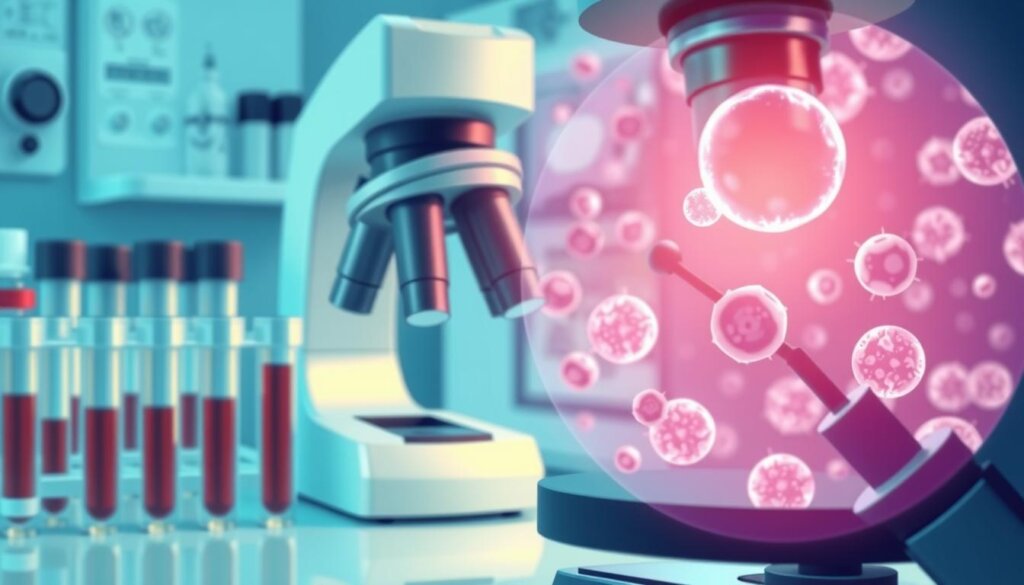
Treatment Options
Leukemia treatment is a complex and personalized process. It is tailored to the specific needs of each patient. The common treatment options include chemotherapy, radiation therapy, and stem cell transplants. These treatments aim to induce remission, where there is no detectable evidence of cancer, and improve long-term survival.
Chemotherapy, Radiation, and Stem Cell Transplants
Chemotherapy uses a combination of anti-cancer drugs to kill leukemia cells throughout the body. Radiation therapy targets and destroys cancer cells in specific areas. It is often used with chemotherapy or before a stem cell transplant. A stem cell transplant replaces damaged bone marrow with healthy stem cells. These cells can then produce normal blood cells. Targeted therapies that attack specific genetic mutations in leukemia cells are also used to treat the disease.
The choice of treatment depends on the type of leukemia, the patient’s age and overall health, and other factors. The goal is to achieve remission and improve the patient’s long-term prognosis. Regular monitoring for minimal residual disease (MRD) is crucial. It can indicate the need for additional treatments to prevent relapse.
“Understanding residual cancer cells can help researchers identify new vulnerabilities in cancer cells and develop targeted treatments to eliminate MRD.”
Prognosis and Survival Rates
Leukemia’s outlook and long-term survival rates depend on many factors. These include the leukemia type, genetic changes in cancer cells, age, and health. Leukemia prognosis has gotten better over time, but it’s still a tough disease.
The National Cancer Institute says the 5-year survival rate for leukemia in the U.S. is 65%. But, survival rates vary by leukemia type. For example, chronic lymphocytic leukemia (CLL) has a 5-year survival rate of 88%. On the other hand, acute myeloid leukemia (AML) has a 5-year survival rate of just 31.7%.
Acute lymphocytic leukemia (ALL) has a 5-year survival rate of 71.3%. Chronic myeloid leukemia (CML) has a 5-year survival rate of 70.6%. But, acute monocytic leukemia (AML-M5) has a 5-year survival rate of only 23.7%.
Getting into remission is a big goal of leukemia treatment. It can greatly improve survival chances. But, genetic changes, age, and health also play a role in prognosis and survival rates.
“Leukemia is a complex disease, and survival outcomes can vary widely. But with continued advancements in treatment and research, we’re seeing more and more people with leukemia achieve long-term remission and improved quality of life.”
It’s key to remember that leukemia’s outlook and survival rates are always changing. People should talk to their healthcare team to understand their own situation and treatment options.
Coping and Support
Getting a leukemia diagnosis can feel overwhelming. But there are many ways to cope. The Family and Medical Leave Act (FMLA) gives eligible workers up to 12 weeks off without pay. Disability insurance can also help with income if you can’t work.
There are programs to help with money too.
Keeping your mind and heart strong is key during tough times. Joining a support group can be a big help. You can talk to others who get what you’re going through.
There’s also a free online community for people with the same diagnosis.
For professional help, check out the Association of Oncology Social Work and others. Taking care of yourself can also help.
Everyone copes differently with leukemia. Some people with high-risk AML use certain coping strategies. Research shows that some strategies are better than others for improving your mind and quality of life.
By using the resources out there, you and your caregivers can face this challenge together. The Leukemia & Lymphoma Society has lots of help, like educational materials and support programs.
Prevention and Screening
There’s no sure way to prevent leukemia for good. But you can take steps to lower your risk. Not smoking is the best thing you can do. Quitting smoking greatly lowers your risk of getting this disease.
Keeping a healthy weight is also important. Being overweight or obese might raise your risk of leukemia. Also, avoid long-term contact with harmful chemicals like benzene and formaldehyde.
There’s no single test for everyone, but regular check-ups and blood tests can help find leukemia early. If you have a family history or other risk factors, you might need more tests. The Moffitt Cancer Center offers help with prevention, screening, and treatment, including clinical trials for new drugs.
Risk Factor | Increased Risk |
|---|---|
Genetics | Rare genetic changes in families may raise leukemia risk. |
Radiation Exposure | High doses of radiation, like from atomic bombs or benzene, link to leukemia. |
Smoking | Smoking might raise the risk of acute myeloid leukemia (AML). |
Immune System Deficiencies | Weak immune systems can lead to cancer, including leukemia. |
Leukemia’s causes are still a mystery, but most types can’t be prevented. Knowing the risks and staying healthy can lower your chance of getting this serious disease.
“Screening refers to the regular use of examinations or tests in individuals at high risk for cancer. It is essential to be aware of specific risk factors associated with different types of cancer for effective screening.”
Research and Clinical Trials
Ongoing leukemia research and clinical trials are finding new ways to fight this disease. They are looking at targeted therapies and immunotherapy to attack cancer cells. Targeted therapies are now a key part of treating some leukemias, with fewer side effects than chemotherapy.
For some, CAR T-cell therapy is being tested, even for older adults. Blinatumomab has also shown to improve survival rates for ALL patients.
In Acute Myeloid Leukemia (AML), the FDA has approved several new treatments. Researchers are working on new drugs like menin inhibitors to stop cancer genes. CAR T-cell therapy and BiTEs are also being tested in AML.
Clinical trials offer new treatments that might work better than old ones. MD Anderson’s leukemia research center has many trials for all stages of the disease. These trials help find more personalized, precision-based treatments for leukemia.
“Clinical trials give patients access to promising new treatments that may offer improved outcomes compared to standard therapies.”
In Chronic Myeloid Leukemia (CML), targeted therapies like imatinib are helping patients. For Chronic Lymphocytic Leukemia (CLL), ibrutinib is the first non-chemo drug approved. Venetoclax and obinutuzumab are also showing promise in treating CLL without chemotherapy.
Zanubrutinib, similar to ibrutinib, has been approved for CLL, with fewer side effects and better results.
Clinical trials are making big strides in leukemia research, offering personalized medicine and better treatments. Specific research programs are improving treatment and survival rates for different leukemias.
As leukemia research keeps moving forward, there’s hope for better treatments and outcomes. Trials are looking at many new treatments, from combination therapies to gene-based interventions. The goal is to improve life for those with this tough disease.
Leukemia in Children
Childhood leukemia is the most common cancer in young people, making up nearly 30 percent of all childhood cancers. About 3,000 kids in the United States get leukemia every year. It’s most common in kids aged 2 to 6. Leukemia can affect any gender and race.
Childhood Leukemia and Its Unique Challenges
Childhood leukemia, especially acute lymphoblastic leukemia (ALL), is different from adult cases. The treatment, which includes chemotherapy and sometimes bone marrow transplants, can affect a child’s growth and development. Kids with Down syndrome or Fanconi anemia are at higher risk.
But, the good news is that survival rates have greatly improved. Now, over 80% of ALL cases survive for 5 years. Researchers are working hard to find better, less harmful treatments.
“Childhood leukemia can be a daunting diagnosis, but with the incredible advancements in treatment and the resilience of young patients, there is hope and the promise of a brighter future.”
Conclusion
Leukemia is a blood cancer that makes too many bad white blood cells. In 2021, 61,090 new cases were found in the U.S., making up 3.2% of all new cancers. We still don’t know all the causes, but genes and the environment play a part. Symptoms can be hard to spot, so seeing a doctor fast is key.
New treatments are helping more people live better lives. In the U.S., 67% of people with leukemia live five years. For kids under 15 in rich countries, the survival rate is even higher, up to 90%. Research and trials are always looking for better ways to fight leukemia.
Leukemia cases have gone up by 0.6% each year since 2006. But deaths from it have dropped by 1.5% yearly. It’s the 10th most common cancer in the U.S., causing 23,660 deaths in 2021. Worldwide, 474,519 cases were reported, with 67,784 in North America.
The global rates for leukemia are about 11 cases per 100,000, with a death rate of 3.2. These numbers show we need to keep working on treatments and research to help those with leukemia.
FAQ
What is leukemia?
Leukemia is a blood cancer. It happens when too many white blood cells grow in the body. These cells take over, making it hard to fight infections and stop bleeding.
What are the different types of leukemia?
Leukemia is split into two main types: acute and chronic. It also depends on the type of white blood cell affected. The main types are acute lymphocytic leukemia (ALL), acute myelogenous leukemia (AML), chronic lymphocytic leukemia (CLL), and chronic myelogenous leukemia (CML).
What are the common symptoms of leukemia?
Symptoms include fever, feeling very tired, and easy bruising. You might also get sick often and have swollen lymph nodes. These signs can be like other illnesses, so seeing a doctor is key.
What causes leukemia?
We don’t know all the causes, but it’s a mix of genetics and environment. Genetic changes in blood cells can cause them to grow too much. Things like past cancer treatment, certain chemicals, and smoking might also play a part.
How is leukemia diagnosed?
Doctors use a physical exam, blood tests, and a bone marrow biopsy to diagnose. A complete blood count (CBC) shows if blood cells are abnormal. Other tests find leukemia cells and figure out the type.
What are the treatment options for leukemia?
Treatments include chemotherapy, radiation, and stem cell transplants. Targeted therapies that target specific genetic changes are also used. The goal is to get into remission and improve survival chances.
What is the prognosis and survival rate for leukemia?
Survival rates vary based on the leukemia type, genetic changes, age, and health. Getting into remission is crucial for better survival chances.
How can patients and caregivers cope with a leukemia diagnosis?
Getting a leukemia diagnosis is tough, but there’s help. It’s important to focus on mental and emotional health. Many groups offer support, education, and financial help.
Can leukemia be prevented?
No, we can’t prevent leukemia yet. But avoiding chemicals and not smoking can lower risk. Regular check-ups and blood tests can help catch it early.
What is the role of research and clinical trials in leukemia?
Research and trials aim to find better treatments. They look at new therapies and ways to manage leukemia. Joining trials can offer new treatments and help improve care.
How does leukemia affect children differently?
Leukemia is common in kids, with ALL being the most common. It affects kids’ growth and development. Thanks to research, treatments have improved, but ongoing work aims for less harmful options.
